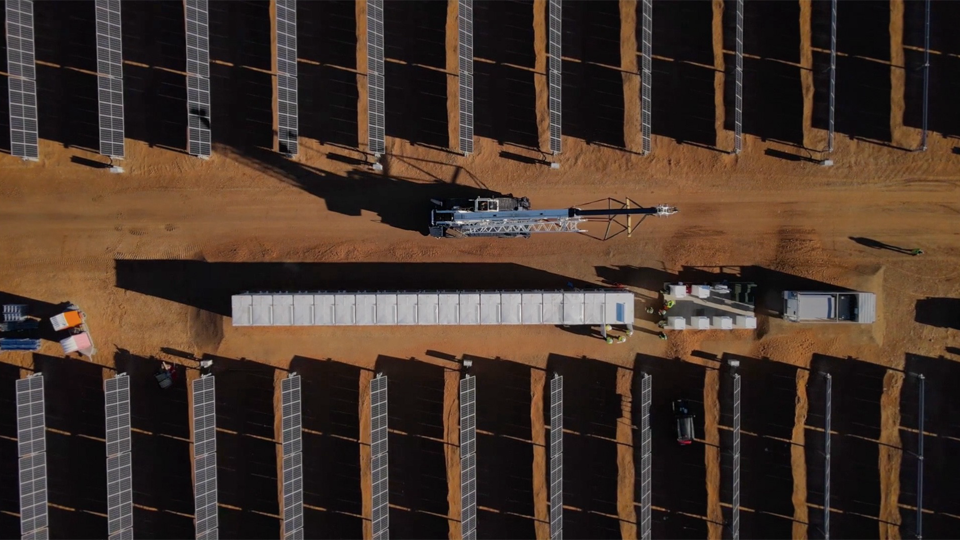By Anthony Carroll, President at Powin (Originally published on CleanTechnica)
Sunday’s Super Bowl saw the Kansas City Chiefs become the first back-to-back Super Bowl champion in two decades. While the Chiefs fans have something to celebrate this week, the game was also a major win for sustainable energy — Super Bowl LVIII was the first powered entirely by renewable energy sources.
How a local renewable energy project powered the Super Bowl
Allegiant Stadium, the home of the Las Vegas Raiders and host of this year’s big game, supplies its power from NV Energy’s Arrow Canyon Solar and Battery Energy Storage System. The 200 MW solar array and 375 MWh battery storage project is located in Moapa, Nevada, within the Mojave Desert, and was developed by solar provider EDF Renewables and Powin, a leading provider of grid-scale energy storage solutions. Made up of 621,000 panels and 564 battery units, Arrow Canyon can generate enough power to meet the needs of up to 76,000 homes. Meeting these energy needs with renewables means avoiding more than 632,000 metric tons of CO₂ emissions annually, or the equivalent of greenhouse gas emissions from 137,000 passenger vehicles driven over one year.
Even though Allegiant Stadium’s energy comes from a unique source compared to other venues, the experience was comparable to what viewers and attendees alike expected from any other stadium, and this massive national event is no small feat. Around 61.2 thousand fans were in attendance, and 123.4 million viewers tuned in to watch the game, making this year’s Super Bowl the country’s most-watched television program of all time. It takes a significant amount of energy to ensure everything runs smoothly for a major national event, and with all eyes on the renewably powered stadium, there was no room for an outage mid-Usher performance. In fact, to operate efficiently, the Super Bowl required a steady 10 MWh power supply. In total, Arrow Canyon’s battery energy storage system (BESS) discharged 166 MWh of DC energy throughout the event, which is about the same amount that it takes to power 34,297 homes for four hours.
Arrow Canyon’s development stemmed from NV Energy’s desire to add 450 MWh worth of renewable energy to its portfolio, and this project significantly contributed to the utility provider’s goal. Originally, the project was intended to solely include solar panels, but considering the vital role battery technology now plays in extending the use of solar energy, adding BESS became essential to creating a more dependable and well-structured system.
Backing up solar power with BESS
If Arrow Canyon’s 600,000+ solar panels are the quarterback, then the battery storage system is the offensive line protecting the team’s investment. The amount of solar energy panels can generate is dependent on the availability of sunlight, which is naturally intermittent due to weather conditions, time of day and season. Variations in weather and a potential lack of sunlight mean that utility-scale solar installations can result in a fluctuating energy supply, which has the potential to destabilize the power grid if not managed properly. Energy storage needs to come into play to ensure there’s power without constant sunlight.
Energy storage systems help mitigate the natural limitations of solar by smoothing out fluctuations and providing grid support services such as frequency regulation and voltage control. These systems hold onto excess energy generated during peak sunlight hours, storing energy for later use, meaning that when the sun’s not shining, a consistent and reliable energy supply is still available. In turn, utility companies can better match supply with demand, reduce the need for peaker plants and optimize the utilization of existing infrastructure. Arrow Canyon is a DC coupled system, providing greater efficiency and lower losses by eliminating the need for additional power conversion equipment.
This was made possible by EDF Renewables’ solar panels and Powin’s batteries, which help bolster Arrow Canyon’s efficiency, reliability and cost-effectiveness, ensuring a steady power supply for the Super Bowl. Storage systems like Powin’s BESS come with added perks, such as improving the economics of utility-scale solar projects by increasing their value and revenue potential. By capturing and storing excess energy, storage systems can participate in energy markets, provide ancillary services and optimize revenue streams through energy arbitrage.
What a sustainably powered Super Bowl means for the future of US power
The ability to power a major sporting event entirely with renewable energy should inspire everyone. This historic milestone is just one example of what is possible when utilities, developers, construction companies and suppliers work together towards a better future. However, there is still significant work to do. These projects are not without challenges — current market dynamics like rising interest rates, longer interconnect queues and delays, as well as technology concerns are all factors delaying key projects.
Moving beyond powering major sporting events to powering entire cities will require a massive growth in renewables and batteries in the U.S. The 2023 S&P Global Commodity Insights estimates that the U.S. BESS market will grow from 8 GW of annual installations in 2022 to 14 GW by 2030, but for the country to make a mass move to clean energy, even more growth is needed. A variety of other factors will also need to align for a successful move toward sustainable power. For example, investments by public and private entities are needed to continue and increase access to renewable energy; tax credits, ITCs, PTCs, and IRA incentives must grow, despite any political direction; and clear guidelines, standardized across the country, are all crucial to widespread adoption of clean energy. Finally, we will need dedicated, responsible industry leaders to continue to drive the U.S. to become a global leader in sustainability and innovation.
We are already starting to see a push toward renewables on a larger scale. For example, the Electric Reliability Council of Texas (ERCOT) has promised to make their grid more reliable to avoid future power and water outages. The first step for energy providers and municipalities is to ensure safe power for people, and the next is to guarantee that a larger percentage of that power comes from sustainable and renewable sources. Batteries can help meet both of these needs.
The ultimate goal is to create truly green cities that provide eco-friendly transportation, incentivize walking and cycling, strongly enforce net-zero self-sustainable buildings and focus heavily on energy efficiency. If we work toward becoming a society that believes in and executes more sustainable behavior, and our transportation and homes reflect that focus, then all we need is readily available sustainable energy to be on the path to smart, sustainable cities.

